Building Out Your Emergency Kit? One of These Best Water Storage Containers is Essential.
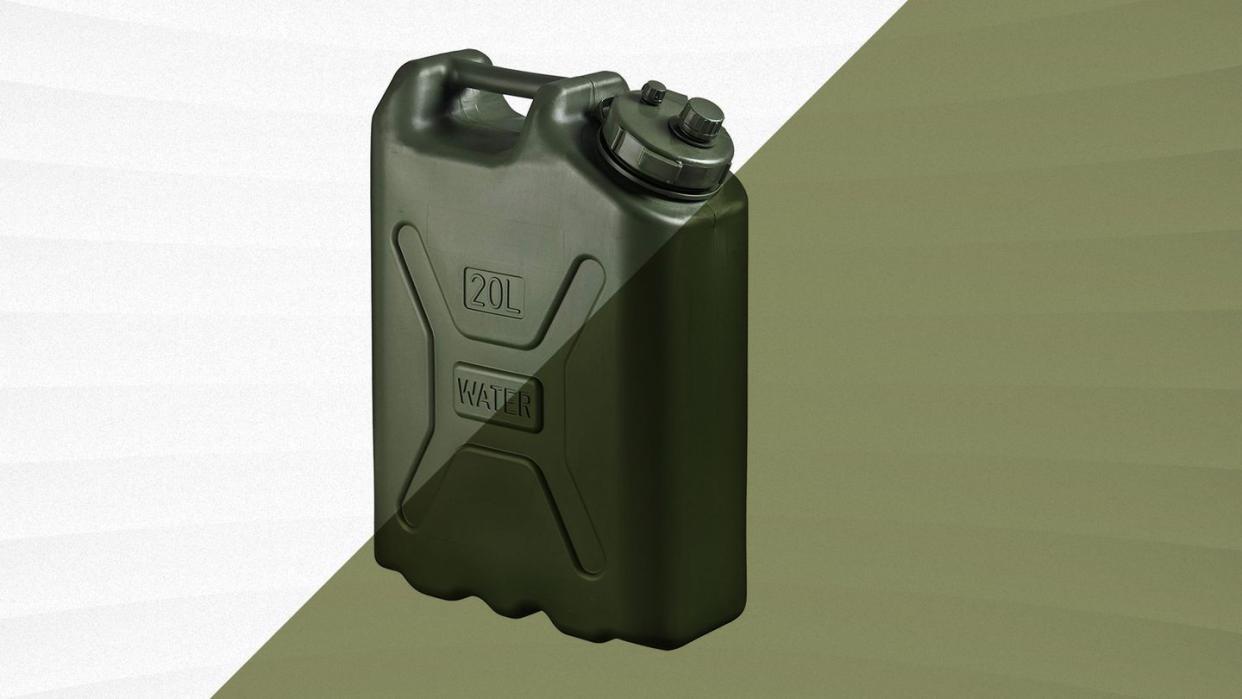
"Hearst Magazines and Yahoo may earn commission or revenue on some items through these links."
Water storage is essential to survival planning. In addition to your other emergency supplies, like food and a generator, access to clean drinking water is paramount. And you have options for ensuring that access. The best water storage containers vary from compact solutions suitable for urban dwellers to robust systems ideal for off-grid homesteads. Here, we delve into a range of possibilities to suit diverse needs and scenarios. We factored in considerations such as durability, capacity, portability, and ease of maintenance, weighing the pros and cons of different containers.
Read on for our evaluations, plus safety and maintenance tips on how to keep your water potable.
The Best Water Storage Containers
Best Overall: Scepter BPA-Free Water Container
Best Budget: Reliance Aqua-Tainer
Best Large Volume: WaterPrepared Stackable Water Tank
Best Stainless Steel: Allentian Stainless Steel Water Can
Best Stackable: AquaBrick Emergency Water Storage Containers
What to Consider
Intended Use
Many people use water containers for emergency preparedness for natural disasters. If this is your case, determine how long you anticipate needing water storage. This will help you figure out the appropriate size and number of containers you’ll need.
Some water storage containers are suitable for more than one type of emergency, but common natural disasters and the recommended types of containers for each are:
Hurricanes and Typhoons: Large, durable containers such as water barrels or heavy-duty plastic drums. These should withstand strong winds and potentially deep water from flooding.
Earthquakes: Lightweight, portable containers, such as a collapsible jug or water storage bags. These need to strike a balance of being sturdy enough to withstand potential structural damage while also easy to transport in case you need to evacuate.
Floods: Elevated water storage tanks or containers with sealed lids to prevent contamination from floodwaters. Plastic drums or water storage tanks designed for outdoor use are suitable options.
Wildfires: Fire-resistant water storage containers, such as metal drums or tanks.
Tornadoes: Water storage tanks stored in underground cisterns or buried tanks that are protected from wind and debris. But portable water containers are also helpful if you store them in sturdy structures like basements or storm shelters.
Droughts: Large-capacity water tanks or reservoirs for long-term storage. These can be above-ground or underground, depending on available space.
Winter Storms and Freezing Temperatures: Insulated water storage tanks or containers designed to withstand freezing temperatures without bursting. Additionally, stockpiling bottled water indoors is advisable to prevent freezing.
Volcanic Eruptions: Sealed water storage containers to protect against ashfall and contamination. Plastic drums or tanks with tight-fitting lids are suitable options.
When trying to decide on container size, assess whether you’re preparing to shelter in place or evacuate. For sheltering in place, you may prefer a larger water storage container like a barrel or cistern. These aren’t very easy to move, however, so for evacuation, you’ll want smaller, portable containers with handles or wheels. Lastly, think about whether the containers can serve other purposes besides water storage, such as storing food or supplies, to maximize their utility in emergency situations.
Materials
High-density polyethylene (HDPE), a popular food-grade material, is highly durable, resistant to corrosion, and has non-leaching properties. HDPE containers are also lightweight, making them easy to transport, and they can withstand a wide range of temperatures without degrading. Ergo, they’re suitable for long-term storage.
Stainless steel is another excellent material for water storage containers. It’s durable, non-corrosive, and does not react with water, maintaining the quality of the liquid inside it. Stainless-steel containers are also resistant to bacterial growth, making them suitable for storing water for extended periods.
Glass containers are preferred as they do not leach any chemicals into the water and are easy to clean. However, glass is more fragile, and containers made with it tend to be heavier than plastic or metal options, which may limit their portability in some situations.
Size and Capacity
Water storage containers come in various sizes and capacities to accommodate different needs and scenarios.
Small containers, typically 1-5 gallons in volume, are suitable for short-term emergencies or portable use. They’re convenient for storing water in vehicles or bug-out bags or for one person to use during outdoor activities. Small containers and portable water filters are also ideal for short-term disruptions in the water supply.
Medium-size containers, ranging from 5 to 20 gallons, strike a balance between portability and capacity. They are suitable for supplying water for small families or individuals for a few days to a week during emergencies. And they’re often stackable, making them space-efficient for storage.
Large containers can hold 30 gallons or more and are your best bet for long-term emergency water storage at home. Large containers may take the form of barrels, tanks, or cisterns and require more space for storage.
Bulk storage solutions are also available for communities or organizations preparing for large-scale emergencies. Water tanks or reservoirs with capacities ranging from hundreds to thousands of gallons are typical for these situations. They are suitable for storing water for communal use and may require specialized infrastructure for installation and maintenance. Because of that investment and that we’re focusing this article on water storage for individuals and families, we don’t include any here.
Safety and Maintenance of Water Storage Containers
Potable water is essential during emergencies, so you may need to filter or purify water stored in the containers. Safety precautions and regular maintenance can prevent contamination and help keep the water safe for consumption during emergencies.
Safety
To keep your water potable, there are several safety precautions you can take, including:
Thoroughly clean and sanitize containers before you first use them and periodically after that to remove any dirt, debris, or microbial growth. Cleaning is a regular part of maintenance, which we’ll explain more of in the next section.
Choose food-grade materials like HDPE, stainless steel, or glass to prevent harmful chemicals from leaching into the water. Use containers that have tight-fitting lids or caps to prevent contamination from insects, dust, or other pollutants.
Store containers in a cool, dark place away from direct sunlight and potential sources of contamination (i.e., bacteria, protozoa, viruses, chemicals, sediment, and organic matter).
If you’re concerned about water quality, consider treating stored water with chlorine or other water purification methods to inhibit bacterial growth and ensure continued safety. Water filtration systems are also helpful in removing any harmful contaminants before drinking.
Maintenance
Regular maintenance helps prevent contamination and ensures the longevity of the containers.
Proper water storage container maintenance tasks include:
Inspections: Inspect containers for signs of damage, such as cracks, leaks, or discoloration, and replace any compromised containers.
Rotation: Rotate stored water periodically, pouring it back and forth between two containers, to maintain freshness and quality. And use the oldest water first and refilling containers as needed.
Cleaning: Regularly rinse out the interior and scrub the exterior of the containers with mild soap and water, especially if you’re storing water for a long time, to prevent microbial growth and odors. Cleaning the outside may seem like it wouldn’t matter in terms of water quality, but it can reduce the chances of environmental contamination.
Monitoring: Check the water quality regularly, taking note of any changes in taste, odor, or appearance, and discard any that seems off.
How We Selected
When considering water storage containers suitable for emergency preparedness, my focus remained on functionality, sustainability, and practicality. Since needs for water storage differ, I also factored in portability and storage. An all-around “perfect” water storage container doesn’t exist for everyone, so I focused my research on the types of emergencies and the storage options best suited to them. I have first-hand testing of some of these water storage containers, while others I selected based on consulting homesteaders, preppers, and emergency preparedness specialists.
As an avid outdoorsperson and traveler, I’ve used the Reliance Aqua-Tainer and Scepter BPA-Free Water Container frequently over the past decade. When I first started traveling cross-country via vehicle and camping along the way, I was fresh out of university, so the Aqua-Tainer was an affordable and reliable option. Even after years of use, I still have this on hand for car camping trips or longer road trips. I got my Scepter when I adopted dogs and needed additional water in a large portable container. Now, I use the Scepter more often, but depending on the trip I may take both.
When living in North Carolina on a homestead, I was in hurricane country. When storms were in the forecast, these containers gave me portable and secure options if the area flooded and I needed to evacuate or if the water was shut off due to damages. Now, living in fire country in Washington state, I keep them handy along with my “go bags” in case I need to evacuate due to wildfires.
The homesteaders and preppers I talked with were primarily people that I personally know who live off the grid or converted their homes to be self-sufficient. While I consulted with them for their product recommendations, they wished to remain anonymous. I have also previously spoken with Brad Greer, an emergency preparedness specialist and CEO of DrySee (a manufacturer of waterproof bandages). Most of his insights came from personal experience after Hurricane Harvey, along with his work in healthcare and government affairs.
Questions I asked my sources—and considered of the water storage containers I own—while choosing these products include:
How easy is it to clean?
How well does the container seal?
How easy is it to get water out and refill?
Is the container easy to carry and transport even when it’s full?
What’s the shape and size for storage or travel?
What are the materials?
Can the materials be repaired?
What’s the projected lifespan?
How durable is the container for extended and varied use?
Can the container work for more than just water?
Combining product research with current market trends, I narrowed down the list to these best options for water storage containers.
BPA-Free Water Storage Container
The Scepter Water Container stands out for its all-around reliability and convenience, which make it suitable for outdoor enthusiasts and emergency preparedness. With its lightweight and portable design, this 5-gallon tank is made from food-grade BPA-free material, helping water remain free of unwanted taste, odor, or chemicals.
The large cap assembly, featuring a smaller pour cap opening and vent, facilitates precise pouring, while a locking tab and plastic tether ensure the cap remains securely fastened to the container.
The tall, narrow construction offers ample capacity without sacrificing portability. Whether off-roading or preparing for unforeseen circumstances, the Scepter BPA-Free Water Container is a dependable and practical choice.
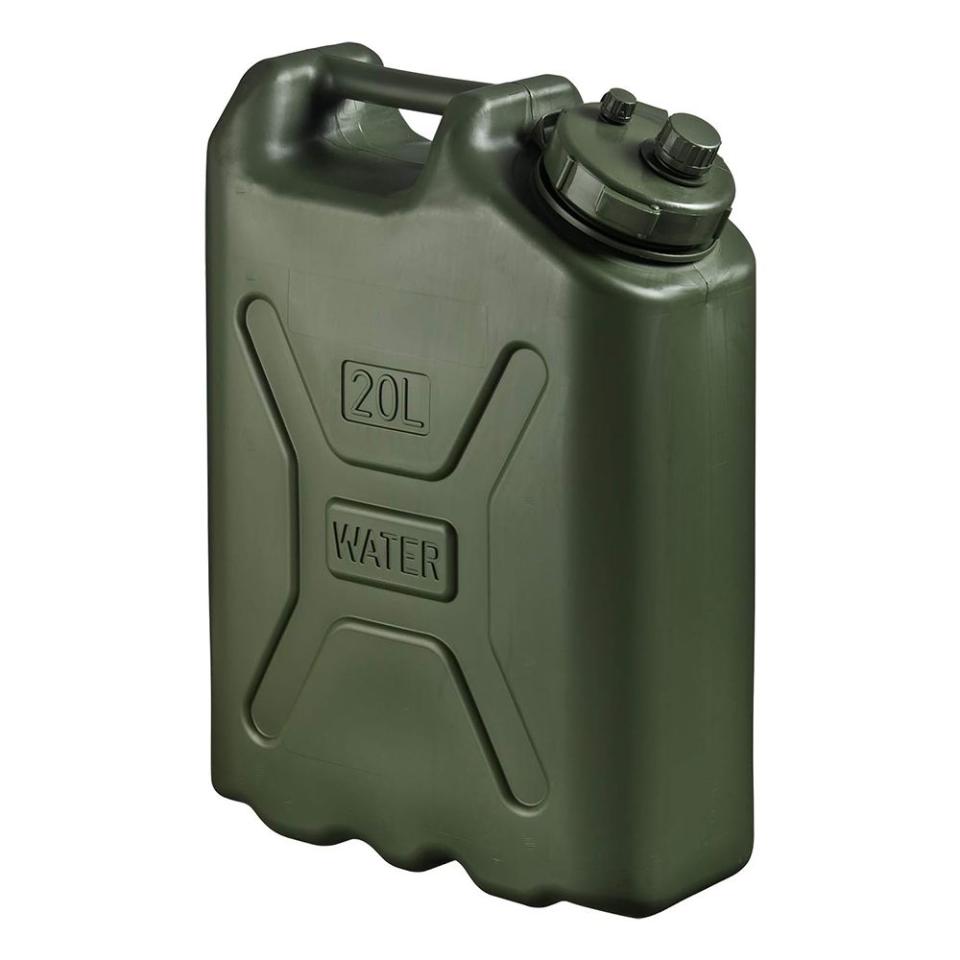
BPA-Free Water Storage Container
amazon.com
$45.99
Aqua-Tainer 7-Gallon Water Storage Container
The Reliance Aqua-Tainer is an affordable and reliable water storage solution for outdoor adventures and emergency preparedness. Despite the low price, it has a surprisingly durable construction with its thick walls.
Equipped with a hideaway spigot, the Aqua-Tainer offers accessible water dispensing while maintaining a sleek and compact design. Its ergonomic contoured handle makes it easy to transport and carry—ideal if you think you might have to evacuate at some point.
With a capacity of 7 gallons, this FDA-approved and BPA-free container provides ample water storage for extended trips, camping, or emergency preparedness.
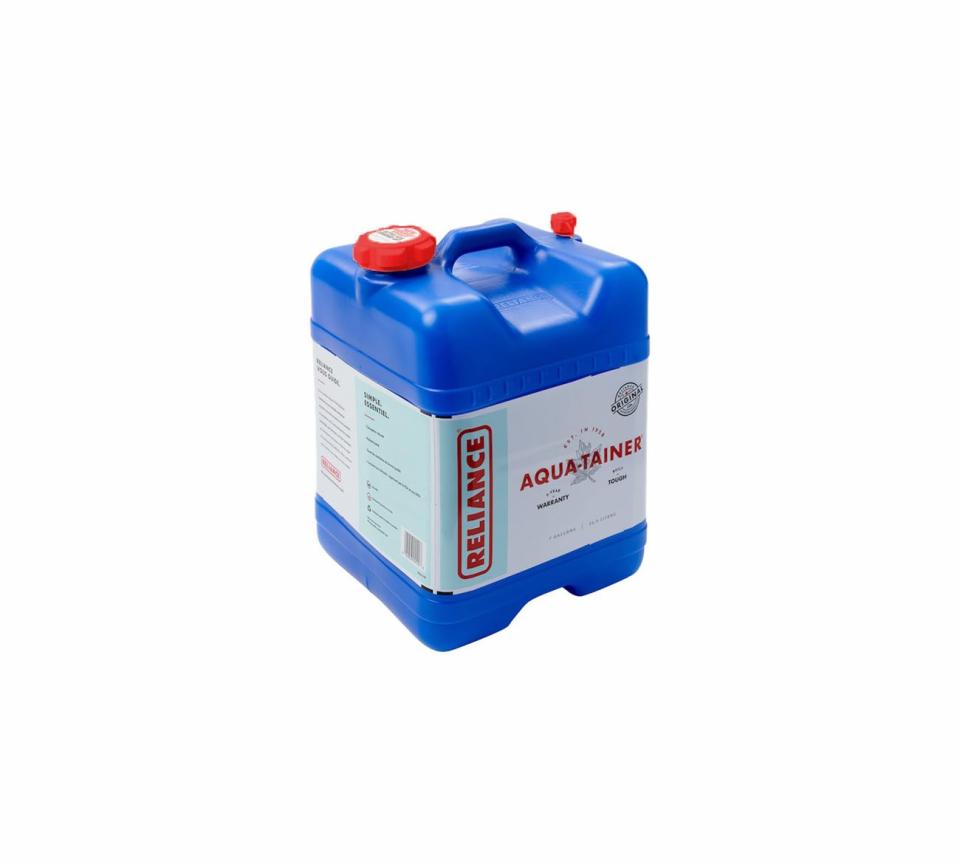
Aqua-Tainer 7-Gallon Water Storage Container
amazon.com
$16.00
Stackable Water Storage Tank
This drum from WaterPrepared is a reliable 55-gallon container well-suited for waiting out disasters. Weighing just 16 pounds (empty), this tank offers convenience while sacrificing a touch of portability. Still, its fairly compact footprint makes it perfect for attachment to ATVs or camping trailers.
Crafted from specially blended UV-proof plastic and HDPE, this tank protects against bacteria build-up, improving the safety of your water supply even during extended storage periods. Accessing emergency water is easy thanks to the included spigots, which are compatible with standard garden hoses, while the front and center “utility valves” enhance flexibility. And if you have limited storage space but want more than one tank, these stack.
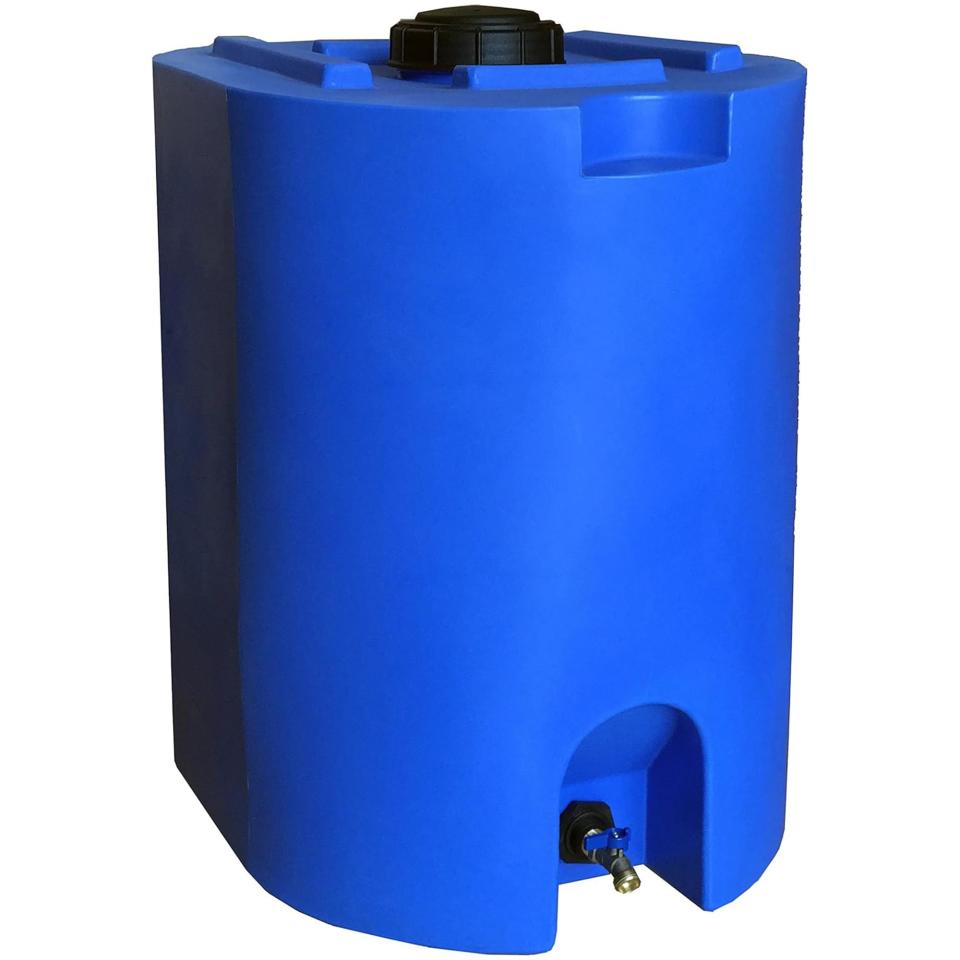
Stackable Water Storage Tank
amazon.com
$310.19
Stainless-Steel Water Can
The Allentian Water Can is made from high-quality 304 stainless steel with a 1mm thickness, offering durability and reliability. With a 5-gallon capacity, it provides ample storage and features a carrying handle for portability. Equipped with a cap, a release valve, and a spout featuring a filter, accessing clean water from this container is easy and convenient.
To improve longevity, Allentian sells spare parts such as the stainless-steel spout hose and waterproof caps. While cleaning is necessary before use, the provided instructions make it simple.
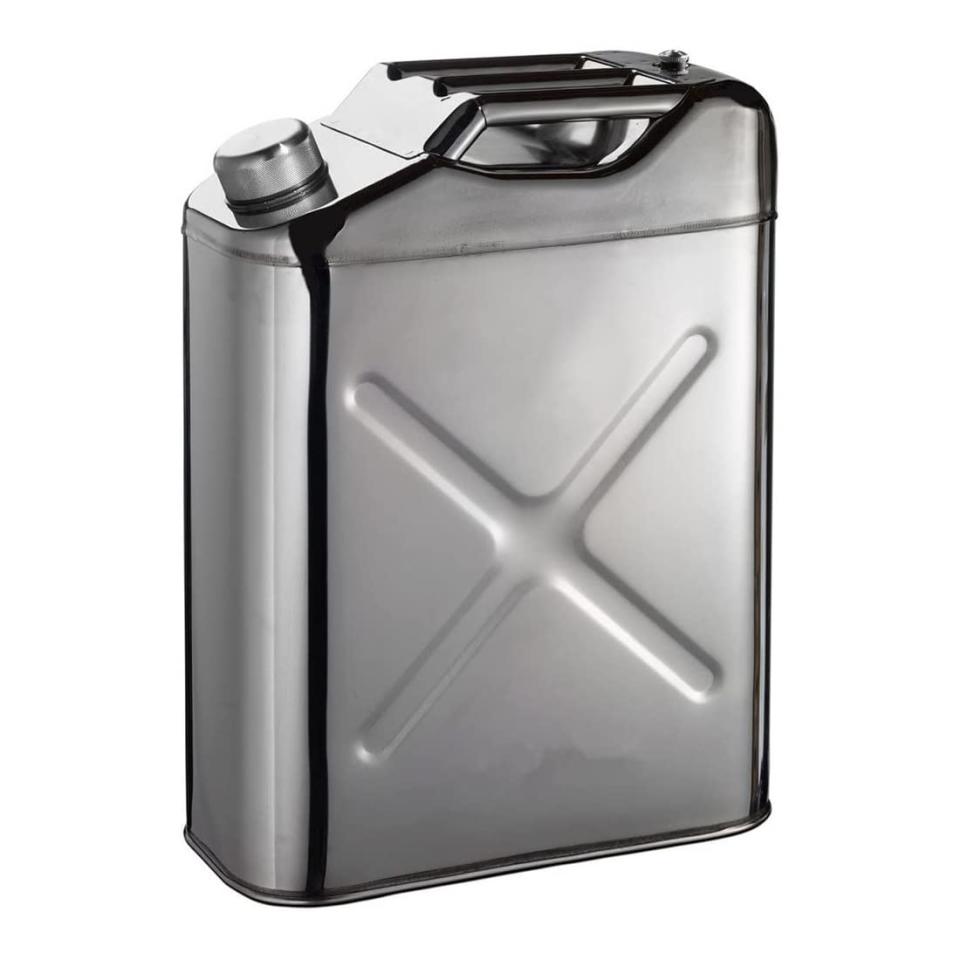
Stainless-Steel Water Can
amazon.com
$269.99
AquaBrick Emergency Water Storage Containers
Constructed from durable HDPE material, this set of stackable containers is guaranteed leakproof, ensuring reliable protection for your supplies. It provides versatile storage options for emergency preparedness with a capacity of 3 gallons of water or 20 pounds of food.
The AquaBrick’s design features integrated handles for easy transport and pouring, while strap grooves allow for secure storage if you need to lash them down. That way, if you have multiple water containers, they will only take up a little space stacked on each other.
Included are a funnel for easy filling and a spigot for hassle-free dispensing. The opaque walls protect stored contents from UV damage to maintain freshness. The only aspect we feel could be improved is the quality of the spigot. It gets the job done but doesn't seem to have a seal that is as tight as the standard lid closure.
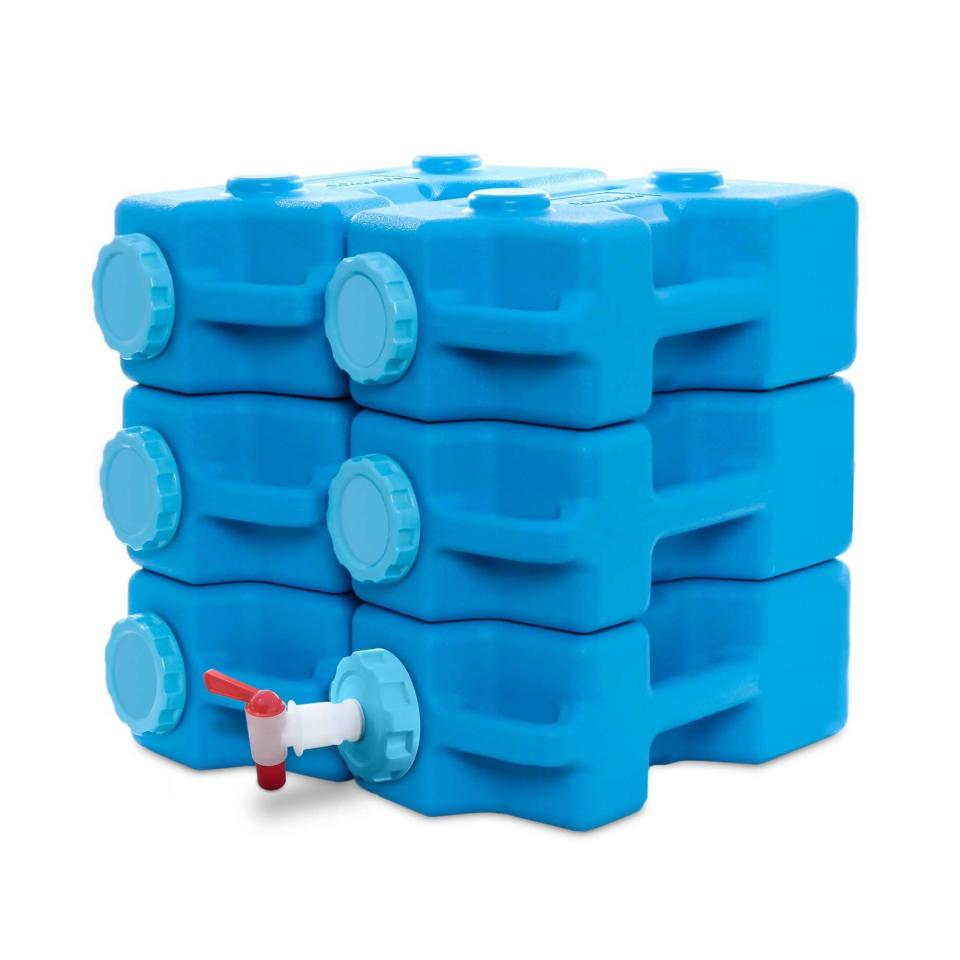
AquaBrick Emergency Water Storage Containers
amazon.com
$185.95
FAQs about Water Storage Containers
Can water storage containers change the taste of the water?
Yes, water storage containers can impact the taste of water. Different materials, such as plastic, metal, glass, or ceramics, can leach subtle flavors or odors into the water over time, especially if you don’t properly clean the container.
For example, plastic containers may release chemicals like BPA into the water, while metal containers can impart a metallic taste. Additionally, stagnant water in poorly maintained containers can develop a stale or off-putting taste. Choosing a high-quality, food-grade container and regularly cleaning it can minimize any negative effects on the taste of stored water.
What are the best materials for container water storage?
The best materials for water storage containers are typically food-grade and inert materials that don’t impart any taste or odor to the water. Glass containers are excellent for small quantities, as they’re non-porous, non-reactive, and won't leach chemicals into the water. Stainless steel is another popular choice as it’s durable, non-corrosive, and won’t impart metallic tastes.
Food-grade plastic containers (HDPE or PET) are also suitable options, but it’s essential to ensure they are BPA-free to avoid potential health concerns. Ceramic containers, especially those with a food-safe glaze, also work for water storage.
How long can you store water?
That depends on its quality, storage conditions, and the type of container. Generally, commercially bottled water has a recommended shelf life of around 1-2 years if you store it in a cool, dark place away from direct sunlight and chemicals.
Tap or purified water can last much longer—potentially indefinitely—if stored in clean, airtight containers made of food-grade materials such as glass or BPA-free plastic. It’s essential to regularly rotate stored water and periodically check for any signs of contamination or degradation in taste or odor. Additionally, treating water with a preservative like chlorine dioxide can extend its shelf life.

You Might Also Like

